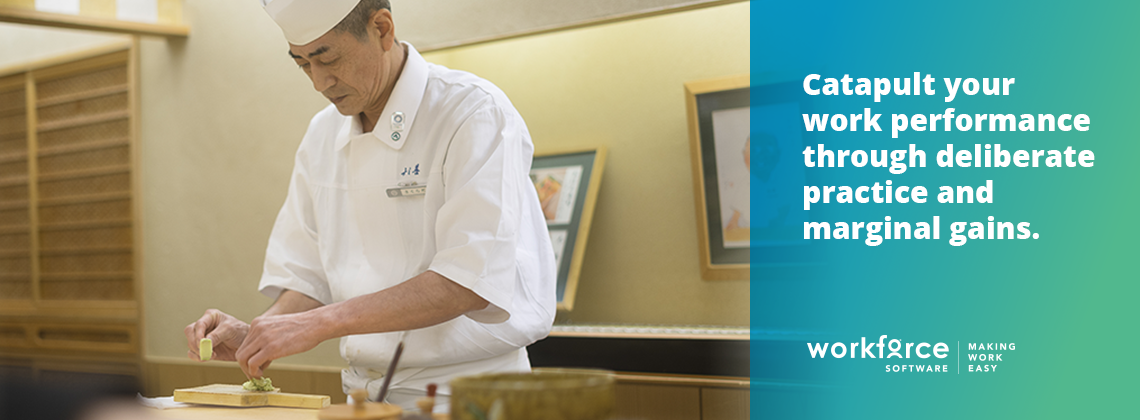The Science of Mastery

Jiro Ono is widely regarded as the greatest sushi chef alive. He’s a true craftsman, what’s known as a “shokunin” in Japan.
His restaurant, Sukiyabashi Jiro, was awarded three Michelin stars, the highest culinary honor. It was also the subject of Jiro Dreams of Sushi, a documentary about work and the pursuit of perfection.
“I had been practicing making the egg sushi for a long time,” said Daisuke Nakazawa, an apprentice for Ono who was being interviewed for the film. Egg sushi, or Tamagoyaki, is basically a Japanese omelet atop a bed of rice. It’s a relatively simple recipe.
“After three or four months, I had made over 200 that were all rejected,” Nakazawa laments to the camera. “When I finally did make a good one, Jiro said, ‘Now this is how it should be done.’ I was so happy I cried.”
Subscribe to The WorkForce Blog
Learn the art and science of maintaining productive, happy, engaged employees.
Deliberate practice creates marginal gains.
When Nakazawa systematically recreated each Tamagoyaki, he was engaging in deliberate practice, a concept coined by renowned psychologist, Anders Ericsson.
Deliberate practice is more than mere repetition. Repeating something over and over won’t necessarily help you develop a nuanced skill.
To improve, two unique components must exist:
- Stretch goals: To force you outside of your comfort zone, where you’ll make mistakes.
- Constant feedback: To point out and help correct those mistakes.
Deliberate practice is about pushing yourself, failing, and learning. It should be uncomfortable. If it’s not, your brain will eventually automate the process, which doesn’t enable growth …
In fact, automation is the death knell of personal progress: It’s impossible to improve when you’re not reflecting, analyzing, adjusting.
Purposeful deliberate practice is the only way to consistently record marginal gains, which add up …
Marginal gains compound, yielding profound improvement.
Suppose that each time you engage in deliberate practice, you walk away one percent better. That’s reasonable, right?
Now let’s say you practice every day.
At that rate, after a year, you’d be 37.8X better than the day you started.
That’s the miracle of compounding. But before you can realize those benefits, you have to know how to put in the work …
How to: Deliberate Practice
At work, deliberate practice could be the difference between growth and stagnation.
Here’s what you do:
STEP 1: Identify an area of weakness.
This may seem obvious, but many people struggle with confronting their flaws and deficiencies. Self-analysis can be painful, particularly at work.
That said, it’s an unavoidable first step. Don’t let discomfort stand in the way of your progress.
STEP 2: Split up that weakness.
“Deliberate practice involves well-defined, specific goals and often involves improving some aspect of the target performance,” writes Anders Ericsson. “It is not aimed at some vague, overall improvement.”
In other words, when you practice, focus on a single aspect of your weakness. Doing so will help you set more specific goals.
Let’s say you’ve identified “business writing” as a weakness. That’s a dense skillset. It can easily be broken down into several elements. For example, can your writing be more:
- Clear: Are your sentences immediately comprehensible?
- Concise: Are you using two or three words when one will do?
- Compelling: Are your readers moved to act on your message?
That’s a lot to focus on all at once. Break it up.
STEP 3: Set challenging goals.
Again, practice should always be a bit uncomfortable. If you’re not pushing yourself, you’re standing still.
“Deliberate practice takes place outside one’s comfort zone,” writes Ericcson. “[It] requires a student constantly try things that are just beyond his or her current ability.”
When you push yourself, you’re more likely to make mistakes. Failure, then, opens you up to critical feedback from a teacher or a mentor, someone skilled in your area of weakness.
STEP 4: Seek honest feedback.
Without a feedback loop, it’s incredibly difficult to identify your missteps.
If you don’t know what you’re doing wrong, how can you adjust it and get better?
No feedback, no progress.
 Workforce Management for the HR Leader’s Soul
Workforce Management for the HR Leader’s Soul
This book will help you create a healthy, rewarding environment for the people that keep your company moving forward.
STEP 5: Repeat. Repeat. Repeat.
Deliberate practice is a simple process, really: Set a stretch goal, fail, learn, refine.
That said, growth is only possible if this process is constantly repeated. Otherwise, any sporadic marginal gains you make will remain just that: Marginal.
The only way to realize a compounding effect is to keep at it, the way Daisuke Nakazawa had …
“I was so happy I cried.”
“It was a long time before Jiro referred to me as a shokunin,” said Nakazawa. “That’s what you strive for after all these years.”
After a decade of deliberate practice, Nakazawa left Sukiyabashi Jiro.
Today, he is the chef/owner of a critically acclaimed restaurant in New York City.
Now he’s the master.

 Workforce Management for the HR Leader’s Soul
Workforce Management for the HR Leader’s Soul